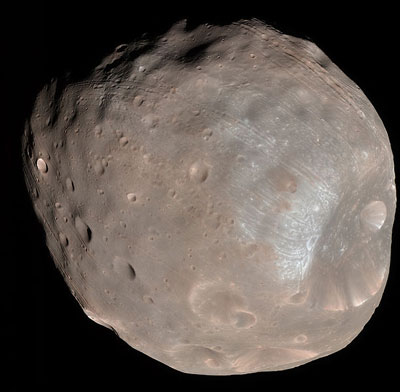



|

|

Curiosity sees Martian moons passing in the night
BY KEITH COOPER
ASTRONOMY NOW
Posted: 16 August 2013

Mars' two moons, Phobos and Deimos, pass in the night high above NASA's Curiosity rover as captured in this superlative video taken with the telephoto lens on the rover's 'Mastcam' instrument. It is the first time that the two moons have been seen eclipsing one another from the surface of the red planet.
Mars' moons are quite different to Earth's Moon, which formed around our planet, likely from the debris of a huge collision with a protoplanet four and a half billion years ago. On the other hand Phobos and Deimos are diminutive asteroids captured by Mars' gravity at some point in the past. As such, they are relatively tiny, potato-shaped rocks. Phobos (seen in the video passing directly in front of Deimos) is 26 kilometres across at its widest point, while outermost moon Deimos is even smaller at 15 kilometres. Both would have fallen into Mars' grasp thanks to big brother Jupiter's gravitational influence. At some point in the distant past both Phobos and Deimos would have resided in the main Asteroid Belt between Mars and Jupiter. The latter planet, being so massive, incurs gravitational resonances deep within the Asteroid Belt. For instance, an asteroid that makes three orbits of the Sun for every one orbit that Jupiter makes will find itself making repeated close approaches to Jupiter at the same point in Jupiter's orbit. This allows Jupiter's gravity to give the asteroid an extra nudge. We call this a resonance (a bit like when you push a child on a swing - push them just as they are at the beginning of the swing's curve and they will swing higher) and similar resonances where asteroids make, for example, two or four orbits compared to Jupiter's one has the effect of clearing out those particular orbits in the Asteroid Belt. Phobos and Deimos may well have been kicked out of the Asteroid Belt by these resonances before encountering Mars.
Both moons are still on the move. Like Earth's Moon, Deimos may be gradually moving further away from Mars, but the future does not look as promising for poor Phobos. As you can see from the video it is much closer to Mars than Deimos - Phobos orbits at 9,370 kilometres above the Martian surface, while Deimos is 23,460 kilometres distant. Phobos' orbit is actually shrinking thanks to gravitational tides from Mars pulling on it, yet Phobos still orbits Mars faster than Mars itself rotates, leading to it rising and setting twice per day from Curiosity's point of view. Within fifty million years Phobos will slip so close to Mars that the red planet's gravity will pull it apart, resulting in a ring of debris that will gradually rain down onto the red planet.

Mars' moon Phobos, imaged by the Mars Reconnaissance Orbiter. The large crater on the nearside is called Stickney. Image: NASA/JPL-Caltech/University of Arizona.
However, Phobos does exert a small gravitational force back onto Mars and scientists on Earth aim to take advantage of this. "The ultimate goal is to improve orbit knowledge enough that we can improve the measurement of the tides Phobos raises on the Martian surface, giving knowledge of the Martian interior," says Mark Lemmon of Texas A&M University. "We may also get data good enough to detect density variations within Phobos and to determine if Deimos' orbit is systematically changing."
Phobos and Deimos (their names are Latin for 'Fear' and 'Dread' respectively, which in Homer's Greek epic The Iliad were summoned by the God of war, Ares, today known as the Roman god Mars) are similar to carbonaceous, C-type asteroids. Their presence close to Mars gives space probes headed to the red planet an opportunity to study a former asteroid up close as well as Mars itself. In 2011 the Russian Space Agency launched a sample-return mission to Phobos, but this failed in Earth orbit. Meanwhile scientists in the United States are designing a potential new mission, called Phobos Surveyor that, if adopted by NASA could launch to Mars' moon sometime in the next decade. It seems we are going to be seeing far more of Mars' natural satellites in the coming years.
|

|

|

|
|



